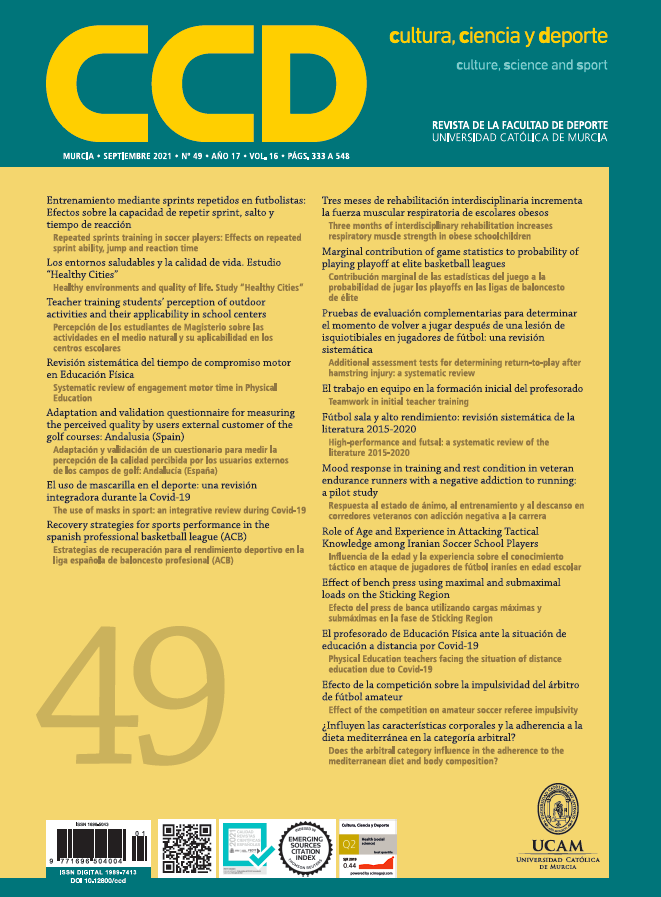Repeated sprints training in soccer players: Effects on repeated sprint ability, jump and reaction time
DOI:
https://doi.org/10.12800/ccd.v16i49.1264Keywords:
resistencia a la velocidad, temporada competitiva, deportes de equipo, fases competitivas.Abstract
Repeated sprint training appears to be an efficient strategy for the simultaneous development of different fitness components in intermittent sport. The aim of this study was to analyze the effects of implement training with repeated sprint training on repeated sprint ability (RSA), reaction time in fatigue condition and jump height. Twenty-seven young soccer players (age 17.7 ± 0.7 years) were assigned to intervention group (GER, n = 14) and control group (GC, n = 13). Both groups perform over four weeks the identical training program with the objective that the previous training did not condition the results and later, GER implement the habitual training with specific intervention (habitual training plus 3 weekly sessions, 2 sets of 8 repetitions on 10-30 meters at maximum intensity) and GC continue with habitual training over the last four weeks of the competitive period. Repeated sprint training not shown significant improvement in mean time (TE = -0.17, Possible Trivial) and decrement (TE = -0.11, unclear) obtained in an RSA test, nor in the difference between the reaction time of sprint 1 and 8 of an RSA test before and after the intervention (TE = 0.27; Clear). The implementation of the habitual training by RST at the end of the competitive season has not shown significant positive effects in the RSA nor in the reaction time in young players.
References
Aughey, R. J., Hammond, K., Varley, M. C., Schmidt, W. F., Bourdon, P. C., Buchheit, M., … Gore, C. J. (2013). Soccer activity profile of altitude versus sea-level natives during acclimatisation to 3600 m (ISA3600). British Journal of Sports Medicine, 47 Suppl 1(Suppl 1), i107-13. doi:10.1136/bjsports-2013-092776
Baker, J., Cote, J., & Abernethy, B. (2003). Learning from the experts: practice activities of expert decision makers in sport. Research Quarterly for Exercise and Sport, 74(3), 342–347. doi:10.1080/02701367.2003.10609101
Balsalobre-Fernandez, C., Glaister, M., & Lockey, R. A. (2015). The validity and reliability of an iPhone app for measuring vertical jump performance. Journal of Sports Sciences, 33(15), 1574–1579. doi:10.1080/02640414.2014.996184
Barnes, C., Archer, D. T., Hogg, B., Bush, M., & Bradley, P. S. (2014). The evolution of physical and technical performance parameters in the English Premier League. International Journal of Sports Medicine, 35(13), 1095–1100. doi:10.1055/s-0034-1375695
Bishop, D., Girard, O., & Mendez-Villanueva, A. (2011). Repeated-sprint ability - part II: recommendations for training. Sports Med, 41(9), 741–756. doi:10.2165/11590560-000000000-00000
Buchheit, M, & Laursen, P. B. (2013). High-intensity interval training, solutions to the programming puzzle: Part I: cardiopulmonary emphasis. Sports Med, 43(5), 313–338. doi:10.1007/s40279-013-0029-x
Buchheit, M. (2012). Should we be recommending repeated sprints to improve repeated-sprint performance? Sports Med, 42(2), 163–169. doi:10.2165/11598230-000000000-00000
Buchheit, M, Mendez-Villanueva, A., Delhomel, G., Brughelli, M., & Ahmaidi, S. (2010). Improving repeated sprint ability in young elite soccer players: repeated shuttle sprints vs. explosive strength training. J Strength Cond Res, 24(10), 2715–2722. doi:10.1519/JSC.0b013e3181bf0223
Buchheit, M, Mendez-villanueva, A., Simpson, B. M., & Bourdon, P. C. (2010). Repeated-sprint sequences during youth soccer matches. Int J Sports Med, 31(10), 709–716. doi:10.1055/s-0030-1261897
Buchheit, M, Mendez-Villanueva, A., Simpson, B. M., & Bourdon, P. C. (2010). Match running performance and fitness in youth soccer. International Journal of Sports Medicine, 31(11), 818–825. doi:10.1055/s-0030-1262838
Campos-Vazquez, M. A., Romero-Boza, S., Toscano-Bendala, F. J., Leon-Prados, J. A., Suarez-Arrones, L. J., & Gonzalez-Jurado, J. A. (2015). Comparison of the effect of repeated-sprint training combined with two different methods of strength training on young soccer players. J Strength Cond Res, 29(3), 744–751. doi:10.1519/JSC.0000000000000700
Carvalho Picolini, L., Saraiva Flôres, F., dos Santos Soares, E., Lopes dos Santos, D., Corrêa Matheus, S., & Corazza, S. (2015). Efeitos da prática de Jump no equilíbrio e no tempo de reação em mulheres. ConScientiae Saúde, 14(4), 585–591.doi: 10.5585/conssaude.v14n4.5818
Chaouachi, A., Manzi, V., Wong del, P., Chaalali, A., Laurencelle, L., Chamari, K., & Castagna, C. (2010). Intermittent endurance and repeated sprint ability in soccer players. J Strength Cond Res, 24(10), 2663–2669. doi:10.1519/JSC.0b013e3181e347f4
Clemente Suárez, V., Muñoz, V. E., & Melús, M. (2011). Fatiga del sistema nervioso después de realizar un test de capacidad de sprint repetidos (RSA) en jugadores de fútbol profesionalres. Archivos de Medicina Del Deporte, 28(143), 174–180. doi: 10.1016/j.apunts.2011.04.003
Cohen, J. (1988). Statistical Power Analysis for the Behavioral Sciences. Hillsdale, N.J: L. Erlbaum Associates.
Eckner, J. T., Kutcher, J. S., & Richardson, J. K. (2010). Pilot evaluation of a novel clinical test of reaction time in national collegiate athletic association division I football players. Journal of Athletic Training, 45(4), 327–332. doi:10.4085/1062-6050-45.4.327
Eniseler, N., Şahan, Ç., Özcan, I., & Dinler, K. (2017). High-Intensity Small-Sided Games versus Repeated Sprint Training in Junior Soccer Players. Journal of Human Kinetics, 60(1), 101–111. doi:10.1515/hukin-2017-0104
Faude, O., Koch, T., & Meyer, T. (2012). Straight sprinting is the most frequent action in goal situations in professional football. J Sports Sci, 30(7), 625–631. doi:10.1080/02640414.2012.665940
Ferrari Bravo, D., Impellizzeri, F. M., Rampinini, E., Castagna, C., Bishop, D., & Wisloff, U. (2008). Sprint vs. interval training in football. Int J Sports Med, 29(8), 668–674. doi:10.1055/s-2007-989371
Fransson, D., Nielsen, T. S., Olsson, K., Christensson, T., Bradley, P. S., Fatouros, I. G., … Mohr, M. (2018). Skeletal muscle and performance adaptations to high-intensity training in elite male soccer players: speed endurance runs versus small-sided game training. European Journal of Applied Physiology, 118(1), 111–121. doi:10.1007/s00421-017-3751-5
Gabbett, T. J., Kennelly, S., Sheehan, J., Hawkins, R., Milsom, J., King, E., … Ekstrand, J. (2016). If overuse injury is a “training load error”, should undertraining be viewed the same way? British Journal of Sports Medicine, 50(17), 1017–1018. doi:10.1136/bjsports-2016-096308
Girard, O., Mendez-Villanueva, A., & Bishop, D. (2011). Repeated-sprint ability part I: Factors contributing to fatigue. Sports Medicine. doi:10.2165/11590550-000000000-00000
Hopkins, W. G., Marshall, S. W., Batterham, A. M., & Hanin, J. (2009). Progressive statistics for studies in sports medicine and exercise science. Medicine and Science in Sports and Exercise, 41(1), 3–13. doi:10.1249/MSS.0b013e31818cb278
Iaia, F., Fiorenza, M., Larghi, L., Alberti, G., Millet, G., & Girard, O. (2017). Short-or long-rest intervals during repeatedsprint training in soccer? PLoS ONE, 12(2), e0171462. doi:10.1371/journal.pone.0171462
Iaia, F., Fiorenza, M., Perri, E., Alberti, G., Millet, G. P., & Bangsbo, J. (2015). The Effect of Two Speed Endurance Training Regimes on Performance of Soccer Players. PLoS One, 10(9), e0138096. doi:10.1371/journal.pone.0138096
Impellizzeri, F. M., Rampinini, E., Castagna, C., Bishop, D., Ferrari Bravo, D., Tibaudi, A., & Wisloff, U. (2008). Validity of a repeated-sprint test for football. Int J Sports Med, 29(11), 899–905. doi:10.1055/s-2008-1038491
McGill, S. M., Chaimberg, J. D., Frost, D. M., & Fenwick, C. M. J. (2010). Evidence of a double peak in muscle activation to enhance strike speed and force: an example with elite mixed martial arts fighters. Journal of Strength and Conditioning Research, 24(2), 348–357. doi:10.1519/JSC.0b013e3181cc23d5
Mendez-Villanueva, A., Hamer, P., & Bishop, D. (2007). Physical fitness and performance. Fatigue responses during repeated sprints matched for initial mechanical output. Med Sci Sports Exerc, 39(12), 2219–2225. doi:10.1249/mss.0b013e31815669dc
Mendez-Villanueva, A., Hamer, P., & Bishop, D. (2008). Fatigue in repeated-sprint exercise is related to muscle power factors and reduced neuromuscular activity. European Journal of Applied Physiology, 103(4), 411–9. doi:10.1007/s00421-008-0723-9
Miller, J. O., & Low, K. (2001). Motor processes in simple, go/no-go, and choice reaction time tasks: a psychophysiological analysis. Journal of Experimental Psychology. Human Perception and Performance, 27(2), 266–289. doi: 10.1037/0096-1523.27.2.266
Mujika, I., Spencer, M., Santisteban, J., Goiriena, J. J., & Bishop, D. (2009). Age-related differences in repeated-sprint ability in highly trained youth football players. J Sports Sci, 27(14), 1581–1590. doi:10.1080/02640410903350281
Nedrehagen, E. S., & Saeterbakken, A. H. (2015). The Effects of in-Season Repeated Sprint Training Compared to Regular Soccer Training. J Hum Kinet, 49, 237–244. doi:10.1515/hukin-2015-0126
Owen, A., Lago-Peñas, C., Gómez, M.-Á., Mendes, B., & Dellal, A. (2017). Analysis of a training mesocycle and positional quantification in elite European soccer players. International Journal of Sports Science & Coaching, 12(5), 174795411772785. doi:10.1177/1747954117727851
Owen, A., Wong del, P., Paul, D., & Dellal, A. (2012). Effects of a periodized small-sided game training intervention on physical performance in elite professional soccer. J Strength Cond Res, 26(10), 2748–2754. doi:10.1519/JSC.0b013e318242d2d1
Pereira Da Silva, N., Kirkendall, D. T., & Leite De Barros Neto, T. (2007). Movement patterns in elite Brazilian youth soccer. The Journal of Sports Medicine and Physical Fitness, 47(3), 270–275.
Rampinini, E., Bishop, D., Marcora, S., Ferrari Bravo, D., Sassi, R., & Impellizzeri, F. (2007). Validity of simple field tests as indicators of match-related physical performance in top-level professional soccer players. Int J Sports Med, 28(3), 228–235. doi:10.1055/s-2006-924340
Rampinini, E., Coutts, A. J., Castagna, C., Sassi, R., & Impellizzeri, F. M. (2007). Variation in top level soccer match performance. Int J Sports Med, 28(12), 1018–1024. doi:10.1055/s-2007-965158
Rampinini, E., Sassi, A., Morelli, A., Mazzoni, S., Fanchini, M., & Coutts, A. J. (2009). Repeated-sprint ability in professional and amateur soccer players. Appl Physiol Nutr Metab, 34(6), 1048–1054. doi:10.1139/H09-111
Rodas, G., Ventura, J. L., Cadefau, J. A., Cusso, R., & Parra, J. (2000). A short training programme for the rapid improvement of both aerobic and anaerobic metabolism. Eur J Appl Physiol, 82(5–6), 480–486. doi:10.1007/s004210000223
Rodriguez-Fernandez, A., Sanchez Sanchez, J., Rodriguez-Marroyo, J. A., Casamichana, D., & Villa, J. G. (2017). Effects of 5-week pre-season small-sided-game-based training on repeat sprint ability. The Journal of Sports Medicine and Physical Fitness, 57(5), 529–536. doi:10.23736/S0022-4707.16.06263-0
Rodriguez Fernández, A., Sánchez Sánchez, J., & Villa Vicente, J. G. (2014). Efectos de 2 tipos de entrenamiento interválico de alta intensidad en la habilidad para realizar esfuerzos máximos (RSA) durante una pretemporada de fútbol. Cultura, Ciencia y Deporte, 9(27), 251–259. doi:10.12800/ccd.v9i27.467
Sánchez-Sánchez, J., García-Unanue, J., Hernando, E., López-Fernández, J., Colino, E., León-Jiménez, M., & Gallardo, L. (2019). Repeated Sprint Ability and Muscular Responses According to the Age Category in Elite Youth Soccer Players. Frontiers in Physiology, 10(June). doi:10.3389/fphys.2019.00175
Schwab, S., & Memmert, D. (2012). The impact of a sports vision training program in youth field hockey players. Journal of Sports Science & Medicine, 11(4), 624–631.
Shalfawi, S. A., Haugen, T., Jakobsen, T. A., Enoksen, E., & Tonnessen, E. (2013). The effect of combined resisted agility and repeated sprint training vs. strength training on female elite soccer players. J Strength Cond Res, 27(11), 2966–2972. doi:10.1519/JSC.0b013e31828c2889
Sillero, B., Silva-Grigoletto, D., Herrera, M., Montero, M., Guillén, A. Y., Castillo, D., & Guillén, Y. (2015). Capacidades físicas en jugadores de fútbol formativo de un club profesional. Revista Internacional de Medicina y Ciencias de La Actividad Física y El Deporte, 15(58), 289–307. doi:10.15366/rimcafd2015.58.006
Suarez-Arrones, L., Tous-Fajardo, J., Nunez, J., Gonzalo-Skok, O., Galvez, J., & Mendez-Villanueva, A. (2014). Concurrent repeated-sprint and resistance training with superimposed vibrations in rugby players. International Journal of Sports Physiology and Performance, 9(4), 667–673. doi:10.1123/ijspp.2013-0238
Taylor, J., Macpherson, T., Spears, I., & Weston, M. (2015). The effects of repeated-sprint training on field-based fitness measures: a meta-analysis of controlled and non-controlled trials. Sports Med, 45(6), 881–891. doi:10.1007/s40279-015-0324-9
Tonnessen, E., Shalfawi, S. A., Haugen, T., & Enoksen, E. (2011). The effect of 40-m repeated sprint training on maximum sprinting speed, repeated sprint speed endurance, vertical jump, and aerobic capacity in young elite male soccer players. J Strength Cond Res, 25(9), 2364–2370. doi:10.1519/JSC.0b013e3182023a65
Vigh-Larsen, J. F., Dalgas, U., & Andersen, T. B. (2018). Position-Specific Acceleration and Deceleration Profiles in Elite Youth and Senior Soccer Players. Journal of Strength and Conditioning Research, 32(4), 1114–1122. doi:10.1519/JSC.0000000000001918
Wilkerson, G. B., Simpson, K. A., & Clark, R. A. (2017). Assessment and Training of Visuomotor Reaction Time for Football Injury Prevention. Journal of Sport Rehabilitation, 26(1), 26–34. doi:10.1123/jsr.2015-0068
Downloads
Published
Versions
- 2021-09-08 (3)
- 2021-09-07 (2)
- 2021-09-06 (1)
How to Cite
Issue
Section
License
Copyright (c) 2021 Creative Commons Attribution License

This work is licensed under a Creative Commons Attribution-NonCommercial-ShareAlike 4.0 International License.
The authors who publish in this journal agree with the following terms:
- The authors retain the copyright and guarantee the journal the right to be the first publication of the work as well as licensed under a Creative Commons Attribution License that allows others to share the work with recognition of the authorship of the work and the initial publication in this journal.
















